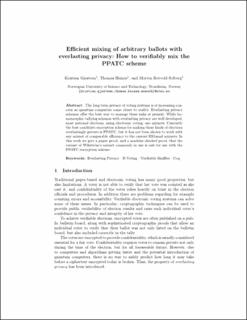| dc.contributor.author | Gjøsteen, Kristian | |
| dc.contributor.author | Haines, Thomas Edmund | |
| dc.contributor.author | Solberg, Morten Rotvold | |
| dc.date.accessioned | 2022-10-05T07:00:31Z | |
| dc.date.available | 2022-10-05T07:00:31Z | |
| dc.date.created | 2021-12-15T09:02:09Z | |
| dc.date.issued | 2021 | |
| dc.identifier.citation | Lecture Notes in Computer Science (LNCS). 2021, 12556 92-107. | en_US |
| dc.identifier.issn | 0302-9743 | |
| dc.identifier.uri | https://hdl.handle.net/11250/3023862 | |
| dc.description.abstract | The long term privacy of voting systems is of increasing concern as quantum computers come closer to reality. Everlasting privacy schemes offer the best way to manage these risks at present. While homomorphic tallying schemes with everlasting privacy are well developed, most national elections, using electronic voting, use mixnets. Currently the best candidate encryption scheme for making these kinds of elections everlastingly private is PPATC, but it has not been shown to work with any mixnet of comparable efficiency to the current ElGamal mixnets. In this work we give a paper proof, and a machine checked proof, that the variant of Wikström’s mixnet commonly in use is safe for use with the PPATC encryption scheme. | en_US |
| dc.language.iso | eng | en_US |
| dc.publisher | Springer | en_US |
| dc.title | Efficient Mixing of Arbitrary Ballots with Everlasting Privacy: How to Verifiably Mix the PPATC Scheme | en_US |
| dc.type | Peer reviewed | en_US |
| dc.type | Journal article | en_US |
| dc.description.version | acceptedVersion | en_US |
| dc.source.pagenumber | 92-107 | en_US |
| dc.source.volume | 12556 | en_US |
| dc.source.journal | Lecture Notes in Computer Science (LNCS) | en_US |
| dc.identifier.doi | 10.1007/978-3-030-70852-8_6 | |
| dc.identifier.cristin | 1968612 | |
| dc.relation.project | Norges forskningsråd: 275516 | en_US |
| cristin.ispublished | true | |
| cristin.fulltext | postprint | |
| cristin.qualitycode | 1 | |
